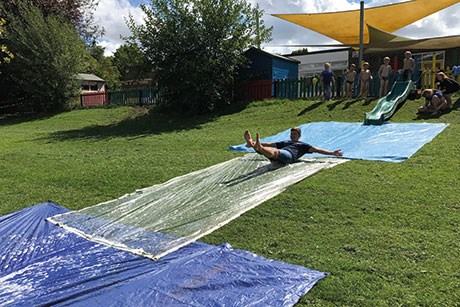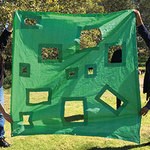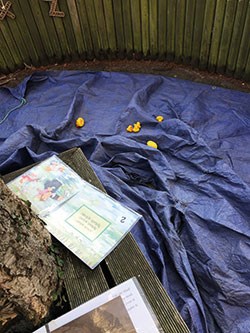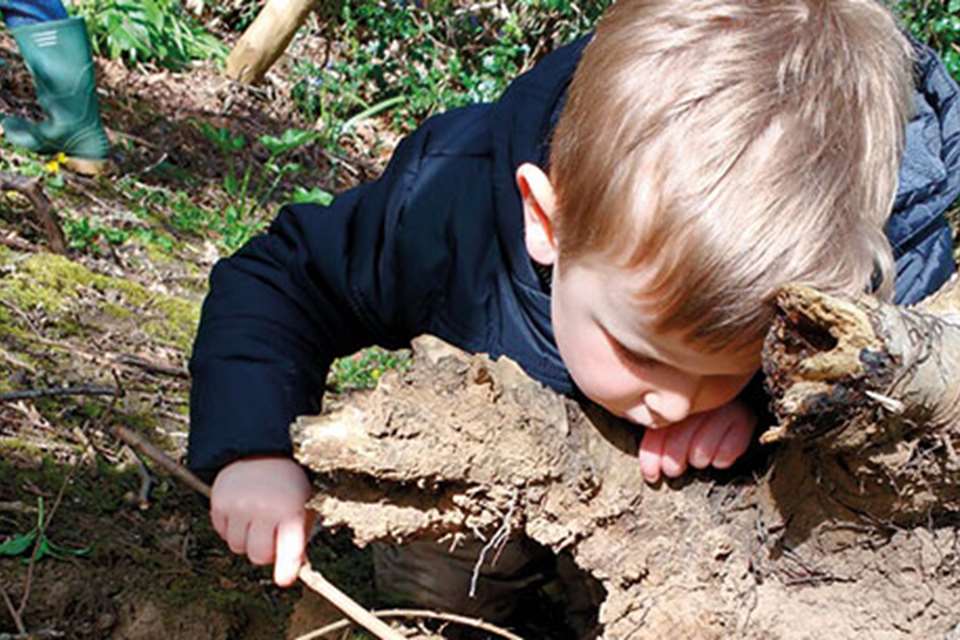EYFS Activities: Five ways to explore… Tarpaulins
Julie Mountain
Monday, February 18, 2019
If you don’t already have a tarp collection at your setting, perhaps these ideas will tempt you, says Julie Mountain

Tarpaulins come in pretty much any size or colour, and with a bit of online searching can be sourced in shapes other than square or rectangular. Tarps are among the most useful outdoor play resources and would definitely be on my ‘Desert Island’ list of must-haves.
1 DISCOVERY TARPS
Quick, simple and fascinating:
Place a coloured tarp (not green) on the ground below a tree or large shrub
whose lower branches you can reach. Shake the tree or shrub and explore the items that fall off onto the tarp. This activity will be unique to the time of year you carry it out, and it is worth revisiting the tree or shrub each season, comparing photographs and children’s own recollections of what was discovered.
Spread a tarp out on the ground. Give children a phonic sound (verbally or on a card) and send them off to find an object that uses that sound (it could be in any part of the word). Blow a whistle or ring a bell to bring children back to the tarp, where they display their objects for everyone to see. Are there any matching objects? If you used a limited palette of phonemes, did children bring back similar objects to represent the sound?
2 RAINY DAY TARP
A ‘glass clear’ tarp is one of the most pleasing outdoor play resources. Glass clear tarps, as the name suggests, are fully transparent and perfect for sheltering under on a rainy day. Set the tarp up at a low height, so that when children are lying under it (on another tarp!), it’s just above their heads. Look up and watch the raindrops splashing onto the tarp – can children predict where they will run off? What does rain look like from below? What happens if they poke the tarp with their fingers?
3 WATER SLIDE TARP
If you’re lucky enough to have even a gentle slope, set up a series of overlapping tarps as a water or mudslide. Few activities are more exhilarating than hurtling down a wet tarp, and the only downside is that children might not want to stop at all.
Fix the tarps in place at the top (or the start, if you’re sliding on level ground) with tarpaulin pegs, which have a flat head and can be easily pushed into the soil. Don’t peg the lower ends, as children might shoot off course and slide over pegs – if you’re overlapping, peg at least 20cm of the next tarp under the previous one. Keep them wet to avoid friction burns and maintain high speeds!
4 DEN TARP
A camouflage tarp will inspire children to create secret places in the natural areas at your setting. Provide long sticks, connectors (see below) and a few old blankets or sheets to sit on, and you have an instant (and cheap) DIY den kit. Inventing and constructing is a crucial part of young children’s development, and den-building meets this need perfectly.
With a selection of tarps in various sizes, children will shape unique, private spaces to create their own environment. Den-building also offers a multitude of physical movements, from whole body (shaking out the tarp, folding it back up, reaching up to connect it to another object…) to the fine and precise actions required to attach a peg or bungee cord securely. ‘Desert’ printed camo tarps are also available and are fun to use in a giant sandpit.
 5 MATHS TARP
5 MATHS TARP
Juliet Robertson has a super maths tarp idea in her Messy Maths book. Cut shapes out of an old tarp, neatening the edges with duct tape (this also helps emphasise the shape). Juliet suggests many ways to use the tarp, including for discussions about shapes, pairs, rotations, and transformations. The maths tarp might also be used for den-building (windows), as a cape, for target practice or as a giant mat. On her tarp, all the shapes are rectangles, to demonstrate that despite their different sizes and proportions, each is still a rectangle. Check out her detailed blog post at https://creativestarlearning.co.uk/early-years-outdoors/give-your-old-tarp-a-mathematical-makeover.
And another thing…
To really make the most of a tarp collection, you will also need a variety of ‘connectors’ such as bungee cords, string and rope, clothes pegs, tent and tarp pegs and a few tarpaulin clips. These will provide opportunities to evaluate the best way to connect a tarp to another object, and the task itself is great for practising fine motor movements. Tarp clips are relatively cheap and, as well as providing extra connection points, will prolong the life of a tarp if (or more likely, when) its edges become tatty through use.








